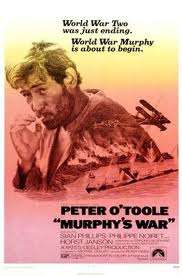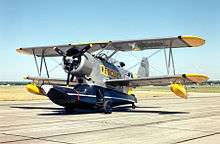Murphy's War
Murphy's War is an Eastmancolor 1971 Panavision war film starring Peter O'Toole and Siân Phillips. It was directed by Peter Yates, based on a novel by Max Catto. The cinematography was by Douglas Slocombe.
| Murphy's War | |
|---|---|
 Theatrical poster | |
| Directed by | Peter Yates |
| Produced by | Michael Deeley |
| Screenplay by | Stirling Silliphant |
| Based on | Murphy's War 1969 novel by Max Catto |
| Starring | Peter O'Toole Siân Phillips Philippe Noiret Horst Janson |
| Music by | John Barry Ken Thorne |
| Cinematography | Douglas Slocombe |
| Edited by | John Glen Frank P. Keller |
Production company | Hemdale Michael Deeley-Peter Yates Films |
| Distributed by | Paramount Pictures |
Release date | January 13, 1971 |
Running time | 107 min. |
| Country | United Kingdom/United States |
| Language | English German |
| Budget | $5 million[1] |
Murphy's War is set in South America, in the backwaters of the global conflict (World War 2). it focuses on a stubborn survivor of a sunken merchant ship who is consumed in his quest for revenge and retribution against the German submarine which had sunk his ship. It is one of a series of novels and/or films from the period following broadly similar themes about personal or community resistance to Nazi forces, and the moral relevance between them, including famous novels like The Secret of Santa Vittoria along with less recognized works like Kramer's War, and others.
Plot
In the closing days of World War II, Irishman Murphy (Peter O'Toole) is the sole survivor of the crew of a merchant ship, Mount Kyle, which had been sunk by a German U-boat and the survivors machine-gunned in the water. Murphy makes it ashore (to a missionary settlement on the Orinoco in Venezuela) where he is treated by a pacifist Quaker doctor, Dr Hayden (Siân Phillips).
When he discovers the U-boat is hiding farther up river, under the cover of the jungle, he sets about obsessively plotting to sink it by any means, including using a surviving Grumman J2F Duck floatplane from the Mount Kyle. The floatplane had been recovered, the wounded pilot later being shot dead in his hospital bed by the U-boat captain, in order to preserve the secret of the sub's location and, presumably, its action in shooting survivors in the water.
Murphy learns how to fly the aircraft in the most daring way, getting it out on the choppy waters of the river and discovering how the controls work by trial and error. Murphy soon finds the U-boat's hiding place and attempts to bomb it using home-made Molotov cocktail bombs, which fails. Meanwhile, word has come that Germany has surrendered, but Murphy is obsessed with revenge and makes plans to ram the U-boat with a floating crane owned by the friendly Frenchman Louis (Philippe Noiret). This also fails as the U-boat dives under him. However, the submerged U-boat becomes stuck in a mud bank. Murphy uses the crane to recover an unexploded torpedo fired earlier from the U-boat and drops it on the trapped crew, killing them. Murphy is also killed, as the explosion from the torpedo causes the crane jib to pin him to the deck as the floating crane sinks to the river bed.
Cast
- Peter O'Toole as Murphy
- Siân Phillips as Dr. Hayden
- Philippe Noiret as Louis Brezon
- Horst Janson as Commander Lauchs, German Submarine Captain
- John Hallam as Lieutenant Ellis, Seaplane Pilot from RNMS Mount Kyle
- Ingo Mogendorf as Lieutenant Voght, Submarine Executive Officer
- Harry Fielder as German Sub Crewman
- George Roubicek as U-Boat Crewman
Production
Peter Yates wanted to make the film. In 1969 Frank Sinatra was going to star but he dropped out[2]
Paramount Pictures agreed to provide half the finance of the film in exchange for world distribution rights.[3] The other half of the budget came from London Screenplays, a finance company.[4] Michael Deeley says that he and Peter Yates turned down the chance to make The Godfather (1972) to make this film.[5]
Director Yates said he was particularly interested in "the way in which three people — Murphy, a doctor and a Frenchman left in the backwash of war — are really brought together by circumstance and how each character plays on the other and makes them do things that they wish they hadn't and things they sometimes feel proud of." [6][3]
Siân Phillips, who played the love interest, was appearing opposite her then-husband O'Toole.[7] The married couple had previously appeared together in the 1964 film Becket and the 1969 musical film Goodbye, Mr. Chips.
Filming began on 23 February 1970, and was completed with location filming in Malta on 5 July, having filmed at a number of locations in the regions of Puerto Ordaz and Castillos de Guayana on the Orinoco River in Venezuela, as well as set filming at Pinewood Studios, Iver Heath and Twickenham Film Studios, Middlesex, England .[8] Deeley described the shoot as the toughest of his career and it led to the breakup of his partnership with Peter Yates, with whom he had made several films.[9]
The scenes filmed in Malta depict the burning of the merchant ship, after it has been torpedoed by the U-boat. For these particular scenes O'Toole was called upon to swim through water afire with oil and with explosives going off right and left of him. "I used to do all my own stunts when I first started" he said. "I made it a principle. Everything in Lawrence of Arabia I did myself. But after suffering a paralyzed hand, a bad back, broken ankle and countless knocks, I decided never again. It was stupid. Films employ stunt men (for a reason!). They can do these things far better than I. I refused to do any more stunts. [Then] I thought, well, just one more time. So I talked myself into it. In Venezuela I even fly a seaplane. If you want to see a picture of sheer terror have a look at the shots of me when I first fly that seaplane."[6]
Several of the sequences were extraordinarily photographed by Douglas Slocombe, including the scenes of Murphy piloting the floatplane and the visuals along the Orinoco River. Especially notable is a spectacular airborne shot of a flock of scarlet ibises in flight along the shore of the river during the closing credits. The extensive flying scene involves many shots of the floatplane veering sharply to avoid buildings, the jungle and stalling – for that sequence, a camera was strapped to the wing of the aircraft.
Several Peace Corps volunteers serving in towns near the Orinoco River were recruited to play Nazi submariners. The volunteers donated their daily wages to the Venezuelan school districts or other organizations with whom they were working at the time.

The Type IX U-boat was portrayed by the Venezuelan Navy's ARV Carite (S-11); this was the former USS Tilefish, which had been sold to Venezuela in 1960. The floating crane was a former World War II tank landing craft. The OA-12 Duck used in the film was restored and flown by Frank Tallman[10] and is on display at the National Museum of the United States Air Force at Wright-Patterson Air Force Base in Dayton, Ohio.[11] In the original book, the aircraft was a Fairey Swordfish.
Reception
Murphy's War was not well received either critically or at the box office. Roger Greenspun's review in The New York Times centered on the awkwardness of the plot: "The sense of a film in which nothing quite works with anything else pervades 'Murphy's War,' and it extends from such crucial technical details as the sloppy and finally tedious cross-cutting between things (the seaplane, the motor barge, etc.) and the people who are supposed to be operating them, to the playing together of the principal actors."[12] A review in Variety stated, "By no means a film classic, 'Murphy's War' stands out as the kind of good, solid entertainment needed these days to fill houses."[13] Gene Siskel of the Chicago Tribune gave the film two stars out of four and called it "an adventure story high in production values but low in suspense."[14] Charles Champlin of the Los Angeles Times wrote, "The story proceeds from the detestable to the improbable by way of the uninteresting. Rarely will you see a major motion picture so flat and devoid of tone or atmosphere. O'Toole's performance is all flash mannerisms and unintelligibly gargled accents."[15] Gary Arnold of The Washington Post called it "a dim, self-defeating adventure movie" with a screenplay "at peculiar cross-purposes with itself ... when the German surrender is announced, the script turns on feisty, vengeful sailor Murphy. All of a sudden it's about the madness of the plan to sink the sub, which, unfortunately, happens to be the raison d'etre of the movie."[16] Although's O'Toole's performance was praised, another review in The New York Daily News called the film a "sluggish action spectacle."[17]
References
Notes
- Blume, Mary (13 December 1970). "A Normandy Movie Invasion". Los Angeles Times. p. u39.
- "'Myra' Generates More Publicity". Los Angeles Times. 6 October 1969. p. e26.
- "Notes: Murphy's War." Turner Classic Movies. Retrieved: 19 August 2013.
- Deeley 2011, p. 83.
- Deeley 2011, p. 82.
- Photoplay Film Monthly, February 1971.
- Wapshott 1984, pp. 157–158.
- "Original Print Information: Murphy's War." Turner Classic Movies. Retrieved: 19 August 2013.
- Deeley 2011, pp. 84–88.
- Air Trails, Winter 1971, p. 15.
- "Grumman OA-12 Duck." Archived 13 October 2012 at the Wayback Machine National Museum of the United States Air Force. Retrieved: 19 August 2013.
- Greenspun, Roger (July 2, 1971). "Murphy s War (1971); O'Toole's head cast in 'Murphy's War'." The New York Times.
- "Film Reviews: Murphy's War". Variety. January 27, 1971. 17.
- Siskel, Gene (July 28, 1971). "Murphy's War". Chicago Tribune. Section 2, p. 5.
- Champlin, Charles (July 7, 1971). "Revenge in 'Murphy's War'". Los Angeles Times. Part IV, p. 14.
- Arnold, Gary (July 9, 1971). "The Trouble With 'Murphy's War': It Loses". The Washington Post. B6.
- Freedland 1985, p. 153.
Bibliography
- Deeley, Michael. Blade Runners, Deer Hunters and Blowing the Bloody Doors Off: My Life in Cult Movies. New York: Pegasus Books, 2011. ISBN 978-1-60598-136-9.
- Freedland, Michael. Peter O'Toole: A Biography. New York: St. Martin's Press, 1985. ISBN 978-0-31260-362-5.
- Wapshott, Nicholas. Peter O'Toole: A Biography. New York: Beaufort Books, 1984. ISBN 978-0-8253-0196-4.